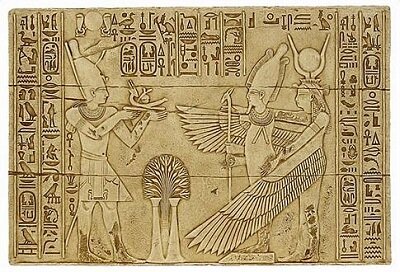The Sunday Section: Ancient Egypt - The Story of Isis
Isis is the goddess of the moon, magic and medicine, wisdom, fertility, love and healing.
Temple of Isis at Philae (Jorge Láscar)
First worshipped in Ancient Egypt, her worship later spread through the Roman Empire, and she is still worshipped today. Seen as the personification of the ‘complete female’, her names include ‘The One Who Is All’ and the ‘Lady of Ten Thousand Names’.
Isis leading Horus and Hathor - Temple of Isis, Philae
She is one of the few deities who actually spent time among the people. She taught women how to make bread, and to weave cloth. She taught her people the skills of reading, and that of agriculture. After the death of her husband, Osiris, she took on the mantle of a goddess of the dead, and of funeral rites.
Isis protecting Osiris with her wings
Her symbols include the full moon, the ankh, rivers and the ocean, papyrus, and wings. As a goddess of the dead, she is shown with a was sceptre – a long, straight staff with a forked end, which represents a stylized animal head. The sceptre was used as a symbol of power, was meaning ‘power’ or ‘dominion’. When shown in a funerary context, the sceptre was responsible for the well-being of the deceased.
Isis leading Nefertari, and holding the ‘was’ sceptre
Isis wears an unusual step headdress, which looks like a throne, and symbolises the throne of Egypt.
Isis with throne headdress
The crown she wears is the cow horns crown, which shows the sun cradled between the horns; it often includes the uraeus.
Isis with cow horn crown, ankh and ‘was’ sceptre
In the beginning, the most powerful of the deities was Ra, the god of the sun. But he was an uncaring god, and humanity suffered. None could usurp him, for none knew his secret name, which was the source of his power over life and death. In the hopes of tricking Ra into divulging his secret name, the goddess Isis conceived a plan. Mixing some of his saliva with mud, she created a snake with the sole purpose of biting Ra. As the snake’s poison mingled with his blood, so too did pain suffuse the sun god. Being the goddess of healing, Isis offered to devise a cure. Unwilling at first, he eventually agreed as the pain increased. She told him that, for the cure to work, she would have to speak his secret name. He refused to give it. Until his suffering became too much to bear, and, reluctantly, he whispered it to her. Isis uttered his name as she performed her magic, and Ra was healed. With the knowledge of Ra’s secret name, Isis, too, possessed the same powers of life and death. Using her powers to benefit the people, she soon became the most powerful of the gods and goddesses.
Isis married her brother, Osiris, and, together, they had Horus. When her brother-husband was murdered by Set, Isis used her magic to restore his body to life. The story of Isis bringing Osiris back to life gained importance during the Greco-Roman period; it was believed that the yearly flooding of the Nile was caused by the sorrowful tears Isis wept for Osiris.
Horus, Osiris and Isis - Louvre Museum (Tangopaso)
Isis suckling Horus (Metropolitan Museum)
I shall tell the story of Isis and Osiris in next week’s Sunday Section.








